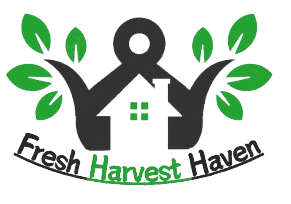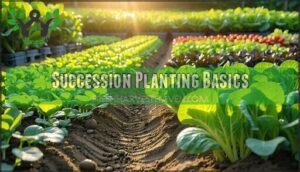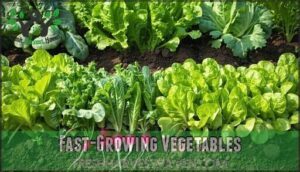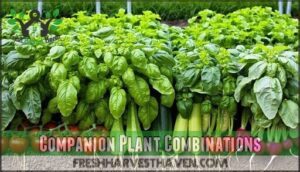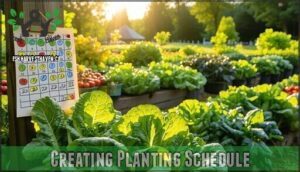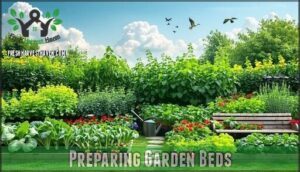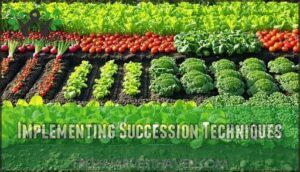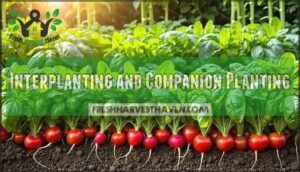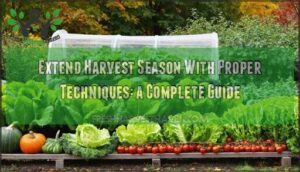This site is supported by our readers. We may earn a commission, at no cost to you, if you purchase through links.
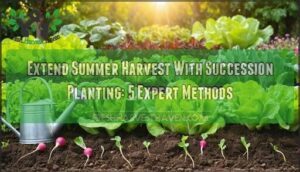 You can extend summer harvest with succession planting by starting new crops every 2-3 weeks throughout the growing season.
You can extend summer harvest with succession planting by starting new crops every 2-3 weeks throughout the growing season.
Think of it like keeping a conveyor belt of fresh vegetables moving through your garden. Plant fast-growing crops like lettuce, radishes, and beans in small batches rather than all at once.
This prevents the feast-or-famine cycle where everything ripens simultaneously. Choose varieties with different maturity dates, and remove spent plants to make room for new ones.
Keep soil consistently moist and add compost between plantings. The secret lies in timing your plantings strategically with your local climate and understanding which specific methods work best for different vegetables.
Table Of Contents
- Key Takeaways
- Succession Planting Basics
- Choosing Right Crops
- Creating Planting Schedule
- Preparing Garden Beds
- Implementing Succession Techniques
- Frequently Asked Questions (FAQs)
- What is the succession planting extension?
- Which are examples of successive planting?
- What are the benefits of succession planting?
- What vegetables do you succession plant?
- How many days between succession planting?
- Do you succession plant in the same spot?
- Should you succession plant celosia?
- How can I manage watering for succession planting?
- What tools simplify succession planting for beginners?
- Can succession planting work in small containers?
- Conclusion
Key Takeaways
- You’ll avoid feast-or-famine cycles by planting small amounts of fast-growing crops like lettuce, radishes, and beans every 2-3 weeks instead of sowing everything at once.
- You can maximize your garden space by intercropping quick crops between slower ones—plant radishes between tomato rows or beans alongside corn for continuous harvests.
- You’ll extend your growing season into fall by selecting cool-weather crops like kale and spinach, starting them in late summer and using row covers for frost protection.
- You must prepare your soil with consistent organic matter and rotate crop families to prevent pest buildup and nutrient depletion throughout multiple planting cycles.
Succession Planting Basics
You can think of succession planting as your garden’s way of avoiding the feast-or-famine cycle that leaves you drowning in tomatoes one week and buying lettuce at the store the next.
This smart technique involves planting small amounts of seeds or transplants at regular intervals throughout the growing season, ensuring you’ll have fresh vegetables ready to harvest when you need them instead of everything ripening at once, which helps to achieve a consistent harvest.
Strategic Timing
Master succession planting timing by syncing your planting schedule with frost date impact and maturity date sync.
Plant fast crops every 7-14 days to extend harvest continuously.
Weather pattern influence affects growth rates, so adjust planting intervals accordingly.
Calculate consumption rate estimates to avoid waste—nobody needs fifty heads of lettuce ripening simultaneously.
Planting interval optimization means staggering sowings based on crop timing and family preferences.
This strategic approach transforms your garden into a reliable food factory, delivering fresh vegetables throughout the growing season.
Space Usage Efficiency
Your garden space is like a game of Tetris—every square inch matters.
Your planting schedule is like a conductor’s baton—timing everything perfectly for a symphony of continuous harvests.
Intensive planting and intercropping benefits help you fit more vegetables into tight spots. Try vertical gardening with trellises for cucumbers and beans, freeing ground space for lettuce rows.
Plant quick radishes between slower tomatoes for maximizing yields. Small garden strategies include replacing harvested crops immediately and using planting intervals of 10-14 days.
Smart garden space optimization through succession planting means you’ll extend harvest season while boosting garden productivity without expanding your plot.
Reducing Pest Pressure
Beyond maximizing space, succession planting becomes your secret weapon against garden pests.
When you stagger plantings, you’re breaking pest life cycles—no more all-you-can-eat buffets for hungry bugs.
Companion planting pairs like basil with tomatoes create natural barriers, while row covers protect vulnerable seedlings.
Smart crop rotation prevents pest buildup in soil.
Choose pest-resistant varieties and welcome beneficial insects to transform your planting schedule into effective pest control through strategic garden planning.
Choosing Right Crops
You’ll get the best results when you pick vegetables that match your garden’s growing conditions and your family’s eating habits.
Smart crop selection combines fast-growing plants like lettuce and radishes with longer-season favorites like tomatoes, creating a steady harvest that won’t overwhelm your kitchen all at once.
Fast-Growing Vegetables
Quick succession planting starts with selecting the right fast-growing vegetables that’ll keep your harvest rolling all season long.
These speedy growers are perfect for filling gaps between your main crops and maximizing your garden’s productivity through strategic Quick Crop Rotation.
Smart gardeners know that understanding Germination Timeframes helps create the perfect planting schedule for continuous harvest:
- Radishes – Ready in just 25 days with minimal Nutrient Requirements
- Arugula – Harvest baby greens in 21 days, low Pest Susceptibility
- Spinach – Fresh leaves in 30 days, perfect for cool weather
- Lettuce – Quick 35-day turnaround with high Harvest Frequency potential
These fastgrowing vegetables thrive with 2-week planting intervals.
Long-Season Crops
While quick crops fill gaps, long-season crops like tomatoes, peppers, and winter squash anchor your succession planting strategy.
These powerhouses produce for months with proper variety selection and staggered starts.
Plan space requirements carefully since they’ll occupy beds longer.
Choose disease-resistant varieties to minimize problems during your extended harvest period.
Smart planting schedule timing means you’ll enjoy fresh produce well into fall, making these crops essential for true harvest extension success.
Companion Plant Combinations
Long-season crops work even better when you pair them with the right companions.
Companion planting creates nutrient synergy while providing natural pest deterrents and growth support. Smart vegetable gardening means maximizing space optimization through strategic partnerships.
- Tomatoes + basil – This classic duo attracts beneficial insects while improving flavor
- Corn, beans, squash – The "Three Sisters" method offers mutual support and soil benefits
- Carrots + radishes – Fast radishes break soil for slower carrots, perfect for succession planting
Creating Planting Schedule
You’ll turn your garden into a year-round producer by mapping out when to plant each crop based on your local frost dates and how long vegetables take to mature.
Think of it like creating a calendar that tells you exactly when to sow seeds, so you’re never stuck with too many tomatoes at once or an empty garden in late summer.
Identifying Frost Dates
Once you’ve picked your crops, frost dates become your garden’s GPS for succession planting success. These dates aren’t just suggestions—they’re your roadmap for extending season harvests and perfecting planting intervals.
Predicting Frost requires understanding your Local Microclimates. Your neighbor’s garden might experience First Frost weeks before yours due to elevation or nearby structures. Historical Data and Zone Hardiness maps provide starting points, but your specific location matters most.
Here’s how to nail down accurate frost dates:
- Check USDA hardiness zones using your exact zip code
- Monitor local weather stations for micro-climate variations
- Track soil temperature alongside air temperature forecasts
- Note elevation differences within your immediate area
- Record actual frost occurrences to build personal Historical Data
Tracking Days to Maturity
Once you’ve pinpointed your frost dates, tracking days to maturity becomes your roadmap to continuous harvest.
Each seed packet reveals plant maturity timelines—use this for harvest prediction and variety selection.
Create a planting schedule that accounts for climate impact on growth rates.
Mark calendars with planting intervals and expected harvest dates.
Adjusting schedules based on actual growth keeps your succession planting on track, ensuring fresh vegetables flow from garden to table.
Estimating Consumption Needs
Now that you’ve pinpointed maturity dates, smart harvest management means matching your succession planting to what you’ll actually eat.
Your continuous harvest should align with family size and dietary preferences while considering storage capacity for waste reduction.
- Calculate weekly consumption: Track how many tomatoes or lettuce heads your household uses per week
- Factor seasonal availability: Plan larger plantings of crops you’ll preserve for winter months
- Maximize yield strategically: Plant smaller, frequent successions rather than overwhelming yourself with huge harvests
Preparing Garden Beds
You’ll get the best results from succession planting when your garden beds are healthy and ready for multiple crops throughout the season.
Think of your soil as a hardworking employee—it needs proper nutrition and rest between jobs to keep producing great harvests all summer long, which is key to succession planting.
Incorporating Organic Matter
The foundation of successful succession planting starts with feeding your soil the right nutrients. Your garden beds need consistent organic matter to support continuous harvest throughout the growing season.
Compost application delivers slow-release nutrients while improving soil structure. Fresh compost feeds beneficial soil organisms that break down materials into plant-available nutrients. Manure benefits include higher nitrogen levels, but aged manure prevents burning tender seedlings.
Nutrient replenishment becomes essential when you’re planting multiple crops in the same space. Each planting cycle depletes soil resources, so consistent organic additions maintain soil fertility. One key aspect involves understanding compost application benefits.
Healthy soil health equals productive harvests!
Using Mulch and Cover Crops
Building on organic matter adds the foundation, but mulch and cover crops take your succession planting game to the next level.
These soil health champions deliver serious mulch benefits like moisture retention and pest suppression while boosting soil fertility naturally.
Here’s your winning strategy:
- Apply 2-inch straw or leaf mulch for instant weed control
- Plant crimson clover between seasons as nitrogen-fixing cover crop types
- Watch your soil improvement accelerate while reducing watering needs
Your garden beds stay productive year-round.
Rotating Crop Families
Smart crop rotation breaks pest cycles and prevents soilborne diseases from wreaking havoc in your garden.
When you plant the same family in one spot year after year, you’re basically rolling out the red carpet for pests and nutrient depletion.
Your succession planting strategy needs thoughtful rotation planning to maximize family benefits.
Crop Family Examples Nutrient Need Rotation Benefit
Adjust your planting schedule and garden planning around these planting intervals for healthier harvests.
Implementing Succession Techniques
You’ve prepared your garden beds, and now it’s time to put your succession planting plan into action with three proven techniques that’ll keep your harvest flowing.
These methods work together like a well-choreographed dance, ensuring you’re never stuck with too much zucchini at once or facing an empty salad bowl in late summer, which helps maintain a continuous harvest.
Staggered Planting Methods
Staggered planting creates continuous harvests by spacing your succession planting efforts across perfect timing intervals.
You’ll avoid the feast-or-famine cycle that plagues many gardens.
Here’s your roadmap to mastering staggered planting:
- Space planting intervals every 7-14 days for quick crops like lettuce and radishes
- Track planting schedules using a simple calendar or garden journal
- Select varieties with different maturity dates to extend harvest windows
- Adjust planting density based on your family’s consumption needs
This approach prevents overlap avoidance issues while maximizing your garden’s productivity throughout the growing season.
Using a planting calendar helps optimize your efforts.
Interplanting and Companion Planting
Pairing crops together creates magic in your garden through succession planting techniques.
Intercropping maximizes Space Optimization by combining fast and slow-growing plants.
Companion planting delivers Pest Deterrents and Nutrient Synergy naturally.
Smart Crop Compatibility means planting radishes between tomato rows—they’re harvested before tomatoes need space.
Beans fix nitrogen for heavy feeders like corn.
These strategic planting intervals boost Yield Maximization while you maintain continuous harvest timing.
Big wins, small space!
Extending Harvest Into Fall
Your garden doesn’t have to surrender when summer ends. Fall Crop Selection with cool-weather champions like kale, spinach, and radishes keeps your harvest rolling through autumn.
Smart succession planting means starting these hardy crops in late summer, giving them time to establish before frost hits. Consider where to purchase your fall crop seeds for the best selection.
- Choose Short-Day Varieties that mature quickly in cooler conditions
- Use Frost Protection Methods like row covers to shield tender plants
- Monitor Soil Temperature Management for ideal germination timing
- Plan Overwintering Strategies for crops that handle freezing temperatures
With proper planting schedules, your fall garden becomes a goldmine of fresh vegetables when others’ gardens go dormant.
Frequently Asked Questions (FAQs)
What is the succession planting extension?
You’ll plant new crops every 1-2 weeks to maintain continuous harvests throughout the growing season.
This technique replaces finished vegetables with fresh plantings, maximizing your garden’s productivity and ensuring you never run out of homegrown produce.
Which are examples of successive planting?
You’ll master succession planting through three key methods: planting lettuce every two weeks, replacing finished peas with beans, and intercropping quick radishes alongside slow-growing tomatoes for continuous harvests.
What are the benefits of succession planting?
Like clockwork, you’ll enjoy continuous harvests instead of feast-or-famine cycles. Succession planting maximizes your garden space, reduces waste from overwhelming harvests, and provides steady fresh vegetables throughout the growing season.
What vegetables do you succession plant?
You’ll have great success with succession planting lettuce, radishes, beans, spinach, carrots, and Swiss chard.
These crops mature quickly, allowing multiple harvests per season when you plant every 2-3 weeks throughout the growing period.
How many days between succession planting?
While impatient gardeners might plant daily hoping for instant gratification, you’ll actually succeed by spacing succession plantings every 10-14 days for quick crops like lettuce and radishes.
Or 2-3 weeks for beans and cucumbers.
Do you succession plant in the same spot?
You can succession plant in the same spot using different techniques.
Try relay planting by staggering crops, intercropping fast growers with slow ones, or replacing finished harvests immediately with new plantings for continuous production.
Should you succession plant celosia?
Celosia doesn’t need succession planting since it blooms continuously once established.
You’ll get steady flowers from one planting all season long.
Focus your succession efforts on vegetables instead—celosia’s already doing the work for you, with steady flowers from one planting.
How can I manage watering for succession planting?
Seventy percent of gardeners struggle with uneven watering schedules.
You’ll need drip irrigation or soaker hoses to maintain consistent moisture across different planting stages, since seedlings need daily water while established plants require less frequent watering.
What tools simplify succession planting for beginners?
Garden journals, planting calendars, and smartphone apps help track your timing perfectly.
Simple measuring tools, seed spacing guides, and row markers keep everything organized.
Start with basic tools—you’ll develop your system as confidence grows.
Can succession planting work in small containers?
Absolutely revolutionary! You’ll maximize your tiniest spaces with succession planting in containers.
Plant lettuce every two weeks, replace finished crops immediately, and use fast-growing varieties.
Small pots become productivity powerhouses with proper timing.
Conclusion
Mastering how to extend summer harvest with succession planting transforms your garden from a one-hit wonder into a productive powerhouse.
You’ll enjoy fresh vegetables from spring through fall while avoiding the overwhelming glut that sends neighbors running when they see you approaching with yet another bag of zucchini.
Start small with lettuce and radishes, then expand your succession planting skills.
Your future self will thank you for the steady supply of homegrown goodness all season long.
- https://forksinthedirt.com/succession-planting-to-extend-your-harvests/
- https://www.finegardening.com/project-guides/fruits-and-vegetables/maximize-your-harvest-with-succession-planting?srsltid=AfmBOoq5JBsHuDjuNMhDRA3lBk-Vx4b4_pw-ufjBjEhXp2ITY7evPJez
- https://www.seedsofchange.com/articles-and-videos/succession-planting
- https://www.floretflowers.com/succession-planting-how-to-keep-the-harvest-going-all-season-long/
- https://midatlantichomestead.com/the-secret-to-double-or-triple-your-garden-harvest-a-printable-to-help-you-plan-it-all-out/
